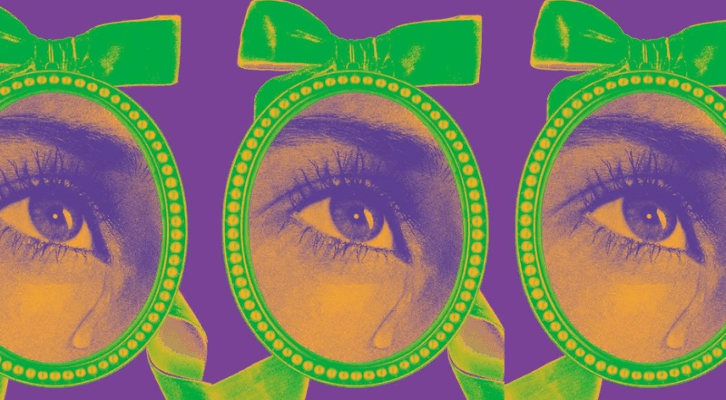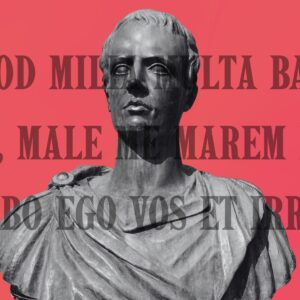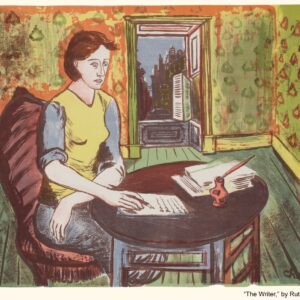
Feminism, Freedom and the Accusatory “You.” On Elaine Kraf's Find Him!
Violet Kupersmith Considers the Stylistic and Thematic Innovations of a Hidden Gem of Experimental Fiction
Find Him!, Elaine Kraf ’s third novel, was first published in 1977 by the experimental author-run Fiction Collective. The book is dedicated to you. And throughout it, you, the reader, will be addressed directly, questioned, sometimes taunted by the novel’s unnamed narrator. The title itself is a desperate plea from her to you.
The book is wildly innovative, almost giddily constructed; in addition to its periodic breaking of the fourth wall, it incorporates musical notation (compositions by Kraf herself), fragments of poetry, streams of different consciousnesses, a questionnaire, and a drawing of a giraffe. The writing style is linguistically unbound, with descriptions of taste and texture and sound and color all dripping into one another. This playfulness of form and syntax counters the novel’s nightmarish plot, the story of an adult woman who awakens one day with the mind and faculties of a child and no memory of her past, and her “education” in isolation at the hands of Oliver, a man who raises her, teaches her, molds her, and abuses her. It is a tale of patriarchal oppression and feminist liberation, but a discomfiting one.
For how can a woman ever truly be free from patriarchy, it asks us, when patriarchal systems have shaped every aspect of her existence—her language, her history, the way she interfaces with the world? One of the most disturbing aspects of Find Him! is the narrator’s steadfast devotion to Oliver despite his subjugation of her. Because she believes she owes her entire personhood to this man, she is either unable or unwilling to ever speak ill of him, even as she describes her horrific treatment at his hands. What Kraf seems to suggest is that freedom, or the closest thing to it, can be found in the subversive power of art. For our narrator, it is through writing this book to you, and even by deceiving you—in a sense, creating her own work of fiction—that she is able to find some autonomy within her story.
What Kraf seems to suggest is that freedom, or the closest thing to it, can be found in the subversive power of art.
The novel begins with our narrator recounting her first moment of consciousness. She is sitting on Oliver’s lap while he spoon-feeds her and orders her to chew. When she spits out her mouthful of meat, he uses his hands to open and shut her jaws for her, manually forcing her to masticate. She instinctively bites his finger, and the act of sinking her teeth into his flesh causes her to match the word “chew” to its meaning. It is her first lesson, and her first word. And for the reader, it is a canny and symbolic introduction to our two central characters and their relationship: Oliver holding the narrator like a ventriloquist’s dummy as he moves her mouth for her; the narrator interpreting the proverb about biting the hand that feeds quite literally; the acquisition of language tied intrinsically to the assertion of agency.
While the narrator is in Oliver’s custody, she is a kind of living doll to him. In her early development, when she is learning to feed and wash herself and use the toilet, he dresses her up “in the costume of a child,” a schoolgirl’s plaid skirt and ruffled blouse. Later on, when his lessons grow more complex—how to read in both English and French, how to cook, how to count—and his methods more cruel—her mistakes or disobedience are punished by food deprivation or being locked in a room—he gives her a purple rayon dress to wear instead.
Though Oliver does not begin having intercourse with the narrator until she graduates to wearing the purple dress, she is a sexual object to him from the very start, even in her mental infancy. The narrator is aware that he gropes her breasts and masturbates in front of her during the schoolgirl skirt era, before she is able to even comprehend it, let alone consent to it. When she reflects on this time, she compares herself to a child or pet and calls herself Oliver’s “hollow instrument,” but still can never fully condemn him, insisting instead that she was lucky to have had him as a sexual instructor, that “had he ignored my woman’s body, my development would have been slowed and possibly impaired.”
The event that prompts the switch from skirt to dress and marks the transition from being fondled to being fucked also comes with another type of sartorial symbolism. The narrator tries on a pair of his trousers, and Oliver is so threatened by this display of independence, by the implications of her wearing the pants, that he beats her, puts her into the new, overtly feminine outfit, and takes full sexual control over her body.
Kraf ’s Oliver is a particularly repellant version of Pygmalion, the most repulsive Henry Higgins imaginable. He is described as a gigantic, ogre-like man who reeks of urine and is usually dribbling saliva from his overhanging bottom lip. The narrator describes (with both tenderness and more than a touch of fiendish glee) his gigantic ears full of impacted wax, and his brown, clawlike toenails that are so thick, he must trim them with a saw. When he isn’t conducting his lessons, Oliver is writing an encyclopedia of great men in history where, among other insanities, he praises Hitler for his commitment to his ideals and claims to have had a personal relationship with Vincent Van Gogh.
“Well, what do you think so far?” the narrator asks you at the end of Part I. “Is he a pervert who kidnapped me and took unfair advantage of me, or is he delusional—paranoid, schizophrenic or some other category?…Or do you think that I am crazy as well as being a pest?…Do you think I am trying to seduce you and manipulate you like some other writers do? Should I have left you out of it and just told the story?”
*
There is one person who might know how the narrator ended up as Oliver’s ward, and her absence hangs over the entire book: Edith, Oliver’s missing wife. The narrator tells us from the beginning that the house she lived in with Oliver was Edith’s. She sneaks in and out of Edith’s old room, trying to piece together who she was from the objects within it, surreptitiously reading letters from Edith to Oliver that he has kept, but ripped the dates off of—there is no reliable method of tracking time in his realm. The purple rayon dress she is given to wear once belonged to Edith.
Find Him! is a story that exists beyond the confines of the page. It asks you, the final character, to sift through its parts and determine what you deem true.
But why does the dress fit the narrator perfectly? Why do the rooms in the house seem not wholly unfamiliar to her, and why do several of Edith’s belongings—a pair of red gloves, an engraved bracelet, a coffee mug—cause a tug of distant recognition? Why does the narrator casually bring up her research about lobotomies and remark that the postoperative condition might closely resemble her own? Why does Oliver never give his charge a name?
Kraf does not hide her clues so much as make them recurring patterns in the kaleidoscope of Find Him!. Edith is or was an artist herself, a creator of stained-glass objects and huge, collage-like tapestries quilted from fabric scraps that drape the hallways of her former home. Her work is an exercise in fragmentation and a mirror of the novel itself, in all its chaotic, pieced-together glory.
Find Him! is a story that exists beyond the confines of the page. It asks you, the final character, to sift through its parts and determine what you deem true. It provides a space for you to draw a picture, if you would like. It encourages you to play the music in the book yourself, or (as I did) find someone else with a piano who can, and experience the narrative through sound: Oliver’s theme, an off-kilter tune with unpleasant interval jumps that never really resolves; “The Mad Giraffe,” a carnival song that grows progressively more demented as it changes keys; and the nameless eight note motif that shifts slightly over the course of the book, like a haunted music box that plays something a little different each time you open it. It is an uncannily brilliant way of making you feel like you are inside the damaged mind of the narrator; the slippery motif never quite allows you to grasp it, remaining, like her memories, somewhere just out of reach.
“I am inviting YOU to enter and eat the feast that OLIVER and I created,” our narrator declares early on. “In order to do this, you must abandon your world, at least temporarily.” Though be warned: partaking in Kraf ’s bizarre feast is like tasting the pomegranate seeds of the underworld—a part of you will never leave this strange book once you enter. There is a bit of sad irony in the fact that Find Him! is a book that was essentially lost for decades, that Kraf ’s tale of a woman with no memory was largely forgotten after being published. But I hope that if Kraf were here she might see it as darkly funny, now that we have finally found each other.
__________________________________

Excerpted from Find Him! by Elaine Kraf. Copyright © 2025. Introduction © 2025 by Violet Kupersmith. Available from Modern Library, an imprint of Random House, a division of Penguin Random House, LLC.
Violet Kupersmith
Violet Kupersmith is the author of the short story collection The Frangipani Hotel and the novel Build Your House Around My Body. She previously taught English with the Fulbright Program in the Mekong Delta and was a creative writing fellow at the University of East Anglia. She has lived in Da Lat and Saigon, Vietnam, and currently resides in the U.S.



















